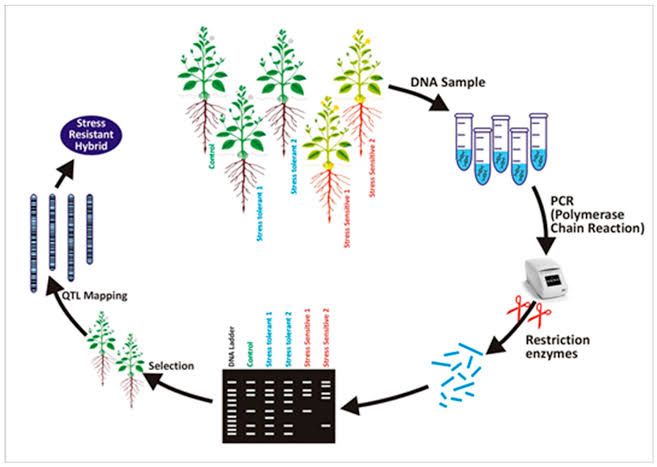
Principles of Identification and Application of Molecular Markers
Molecular markers are specific sequences in the genome that can be used to identify genetic variation among individuals. They serve as important tools in plant breeding, allowing for the selection of desirable traits without the need for phenotypic expression. The principles of identification and application of molecular markers include:
- Types of Molecular Markers: There are several types of molecular markers, including:
- Restriction Fragment Length Polymorphisms (RFLPs): These markers are based on variations in DNA sequences that result in different fragment lengths after digestion with restriction enzymes.
- Random Amplified Polymorphic DNA (RAPD): This technique amplifies random segments of DNA using short primers, resulting in polymorphic bands.
- Simple Sequence Repeats (SSRs) or Microsatellites: These are repeating sequences of 1-6 base pairs found throughout the genome, which exhibit high variability.
- Single Nucleotide Polymorphisms (SNPs): SNPs represent a single base pair change in the DNA sequence and are the most abundant type of genetic variation.
- Identification Techniques: The identification of molecular markers involves techniques such as PCR (Polymerase Chain Reaction), sequencing, and gel electrophoresis. These methods allow researchers to amplify and visualize specific DNA regions.
- Applications: Molecular markers are applied in various areas including:
- Genetic Mapping: Identifying the location of genes associated with specific traits.
- Marker-Assisted Selection (MAS): Using markers linked to desirable traits to select plants during breeding programs.
- Genetic Diversity Studies: Assessing genetic variation within and between populations.
Genotyping Tools in Plant Breeding
The evolution of genotyping tools has significantly impacted plant breeding practices. From RFLPs to SNPs, these tools have become more efficient and cost-effective:
- Restriction Fragment Length Polymorphisms (RFLPs): RFLPs were one of the first molecular marker technologies used for genetic mapping. They require a relatively large amount of DNA and involve labor-intensive procedures.
- Amplified Fragment Length Polymorphisms (AFLPs): AFLPs combine RFLP and PCR techniques, providing a higher resolution than RFLPs while still being relatively complex.
- Simple Sequence Repeats (SSRs): SSRs became popular due to their high polymorphism rates, ease of use, and ability to be multiplexed for simultaneous analysis.
- Single Nucleotide Polymorphisms (SNPs): SNPs have emerged as the preferred marker due to their abundance across genomes, high throughput capabilities, and lower costs associated with genotyping technologies such as next-generation sequencing (NGS). SNP arrays allow for thousands of SNPs to be analyzed simultaneously.
- Integration into Breeding Programs: Modern breeding programs utilize these genotyping tools for rapid assessment of genetic diversity, trait association studies, and selection processes that enhance efficiency compared to traditional methods.
A Model Crop Species – Molecular Markers in Rice
Rice (Oryza sativa) serves as an excellent model crop species for studying molecular markers due to its economic importance and well-characterized genome:
- Genomic Resources: The complete sequencing of the rice genome has provided a wealth of information regarding gene function and organization.
- Application of Molecular Markers:
- SSRs have been extensively used in rice breeding programs for mapping quantitative trait loci (QTL) associated with agronomic traits such as yield, disease resistance, and abiotic stress tolerance.
- SNP markers have also been developed specifically for rice varieties, facilitating MAS in breeding efforts aimed at improving crop performance under varying environmental conditions.
- Impact on Breeding Strategies: The integration of molecular markers into rice breeding has led to faster development cycles for new varieties that meet consumer demands while addressing challenges like climate change.
From Markers to Cloned Genes
The process from identifying molecular markers to cloning genes involves several steps:
- Mapping Traits: Initially, QTL mapping is performed using molecular markers linked to traits of interest identified through phenotypic screening.
- Fine Mapping: Once QTL regions are identified, fine mapping is conducted using denser marker coverage to narrow down candidate genes associated with specific traits.
- Map-Based Cloning:
- This approach involves isolating genes by exploiting recombination events within mapped regions.
- Researchers identify candidate genes based on sequence homology or functional annotations from databases.
- Functional validation is then performed through gene knockout or overexpression studies.
- Genomic Analysis in Crop Breeding:
- Genomic technologies such as whole-genome sequencing enable comprehensive analysis at a genomic level.
- Comparative genomics allows breeders to identify conserved genes across species that may confer beneficial traits when introduced into rice or other crops through transgenic approaches or conventional breeding methods.
In conclusion, molecular markers play a crucial role in modern plant breeding by facilitating precise selection processes that enhance crop improvement efforts across various species including rice.







